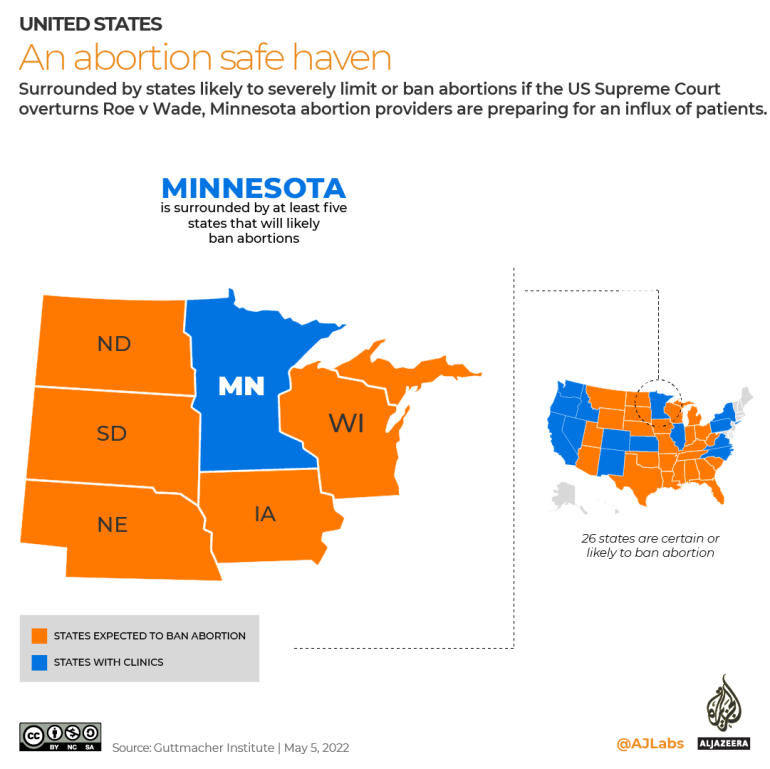Minnesota’s abortion clinics brace for influx in wake of Roe leak | Women’s Rights News
Minneapolis, Minnesota – Pregnant women in North and South Dakota can still technically access abortions in their states despite living in two of the six US states with just one abortion clinic. However, should the draft of the United States Supreme Court decision leaked on Monday night hold and Roe v Wade be overturned, “trigger laws” set to take effect the moment Roe falls in North Dakota, South Dakota, and 11 other states would immediately ban abortion.
That would leave Minnesota as something of an island state in the American Midwest, allowing abortion while encircled by others that would either immediately or swiftly outlaw the practice. Providers across the state are bracing for an influx of demand from people from surrounding states on top of the travellers they have already been seeing from the south since a Texas abortion ban took effect this fall.
“In Minnesota, abortion is protected not only under federal law momentarily but also state law under the 1995 Doe v Gomez Minnesota Supreme Court case,” said Laura Hermer, a law professor at Mitchell Hamline School of Law in St Paul, Minnesota.
Considering the state’s Democratic governor and Democrat-controlled house, “that should remain intact at least for now”, she told Al Jazeera. The same cannot be said for the states surrounding Minnesota, though.
“Both North and South Dakota have trigger bans. In other words, they have laws that say if and when Roe v Wade and Planned Parenthood v Casey” — another critical US Supreme Court decision that protects abortion — “are overturned, abortion shall become illegal in the state”, Hermer said.
To the east, “Wisconsin has an old pre-Roe ban from the mid-1800s that would spring back into effect”, Hermer says, noting that there are questions around what exactly the effect of the law would be. 
To the south in Iowa, the state’s Supreme Court has determined that the Iowa constitution provides the right to an abortion. But “the Iowa legislature is trying to amend the state constitution to remove that protection and the governor is actively at work in this regard as well,” Hermer said.
In nearby Michigan, abortion would become illegal thanks to a 1931 law linked to an 1846 ban that makes performing abortions a felony. Michigan Governor Gretchen Whitmer is currently suing to get rid of the law.
Even with abortion still legal in the US, Minnesota clinics already see high numbers of patients from out of state. Sean Mehl, the associate director of Whole Women’s Health which operates a clinic in the state, estimates that about 30 percent of the abortions they provide now are to people who come from outside Minnesota.
“We have already seen quite a significant number of patients travelling to our Minnesota clinic largely due to [the Texas ban] displacing hundreds and thousands of people across the US,” he said. “We expect that to increase as Roe will likely be chipped away.”
Mehl added that his clinic works to ensure that it offers some availability for services within one week of contacting the clinic for people who are further along in their pregnancies, but that wait times already average upwards of six weeks across the state. With the possibility of a post-Roe future looming, Mehl’s team is working to expand their services. He hopes to add more days when abortions are provided and offer procedures up to approximately 24 weeks of gestation compared with their current 18 weeks, but staffing and funding are persistent challenges.
As clinics like Mehl’s that are based in the Twin Cities metro area in the southern part of Minnesota see an increase in patients, other providers in more remote areas of the state are feeling the effects as well.
Located in Duluth in northern Minnesota, Laurie Casey, the executive director of We Health Clinic, says, “Since the Texas law, we’re seeing more individuals from the metro area because their clinics are busy. The people living in the state are having a harder time accessing abortion because of the uptick in the numbers.”
Should Roe fall and abortion become illegal in surrounding states, Casey expects to see an increase in the 19 percent of We Health’s patients who are already coming largely from Wisconsin and Michigan’s Upper Peninsula. “We would probably have to add some other days during the week when we do abortions, so we’d have to look at having enough staffing,” she says of expanding beyond the one or two days a week they offer abortions now.
The funding challenges that would create come on top of the strains they already have, especially as a clinic that accepts medical assistance. “We charge $700 for an abortion up to 11 weeks,” Casey says. “When we bill Minnesota’s medical assistance, we get back less than $300 for each procedure. We lose money on every procedure” because the algorithms that the state uses to determine reimbursements do not match reality.
Despite the challenges that almost certainly lay ahead, donations to both We Health and Whole Women’s Health have been increasing since Monday.
“Now and in the coming months it’s more important than ever to make those donations,” Mehl says. “I think we’re all really looking to Minnesota as a safe haven right now and are absolutely hopeful to see Minnesota really lead in abortion access.”

Pingback: 토렌트 다운
Pingback: https://www.dallasnews.com/marketplace/2023/09/29/phenq-reviews-legit-diet-pills-or-fat-burner-scam/
Pingback: go to this web-site
Pingback: Sciences Diyala
Pingback: webpage
Pingback: online chat
Pingback: live webcams
Pingback: prices app for UK
Pingback: see more
Pingback: Cbd gummies uk